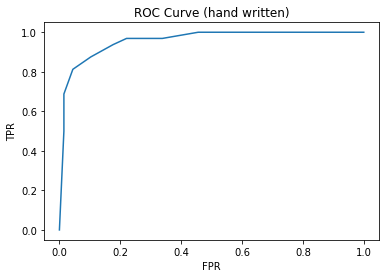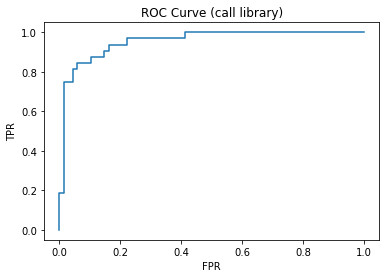机器学习—分类3-4(逻辑回归与ROC)
基于逻辑回归预测客户是否购买汽车新车型ROC曲线
主要步骤流程:
- 1. 导入包
- 2. 导入数据集
- 3. 数据预处理4. 构建逻辑回归模型
- 3.1 检测缺失值
- 3.2 生成自变量和因变量
- 3.3 查看样本是否均衡
- 3.4 将数据拆分成训练集和测试集
- 3.5 特征缩放
-
4.构建逻辑回归模型
-
5. 手工画出ROC曲线
-
6. 调用库画出ROC曲线
-
7. 得到AUC分数
1. 导入包
In [1]:
# 导入包
import numpy as np
import pandas as pd
import matplotlib.pyplot as plt
2. 导入数据集
In [2]:
# 导入数据集
dataset = pd.read_csv('Social_Network_Ads.csv')
dataset
Out[2]:
3. 数据预处理
3.1 检测缺失值
In [3]:
# 检测缺失值
null_df = dataset.isnull().sum()
null_df
Out[3]:
3.2 生成自变量和因变量
为了可视化分类效果,仅选取 Age 和 EstimatedSalary 这2个字段作为自变量
In [4]:
# 生成自变量和因变量
X = dataset.iloc[:, [2, 3]].values
y = dataset.iloc[:, 4].values
3.3 查看样本是否均衡
In [5]:
# 查看样本是否均衡
sample_0 = sum(dataset['Purchased']==0)
sample_1 = sum(dataset['Purchased']==1)
print('不买车的样本占总样本的%.2f' %(sample_0/(sample_0 + sample_1)))
3.4 将数据拆分成训练集和测试集
In [6]:
# 将数据拆分成训练集和测试集
from sklearn.model_selection import train_test_split
X_train, X_test, y_train, y_test = train_test_split(X, y, test_size = 0.25, random_state = 0)
print(X_train.shape)
print(X_test.shape)
print(y_train.shape)
print(y_test.shape)
3.5 特征缩放
In [7]:
# 特征缩放
from sklearn.preprocessing import StandardScaler
sc = StandardScaler()
X_train = sc.fit_transform(X_train)
X_test = sc.transform(X_test)
4. 构建逻辑回归模型
In [8]:
# 构建逻辑回归模型并训练模型
from sklearn.linear_model import LogisticRegression
classifier = LogisticRegression(penalty='l2', C=1, class_weight='balanced', random_state = 0)
classifier.fit(X_train, y_train)
Out[8]:
In [9]:
# 预测测试集(得到预测结果)
y_pred = classifier.predict(X_test)
print(y_pred[:10])
In [10]:
# 预测测试集(得到概率)
y_pred_proba = classifier.predict_proba(X_test)[:,1]
print(y_pred_proba[:10])
5. 手工画出ROC曲线
In [11]:
# 手工画出ROC曲线
from sklearn.metrics import confusion_matrix
threshold_list = []
tpr_list = []
fpr_list = []
for i in range(11):
threshold = i * 0.1 # threshold 分别为0、0.1、0.2、0.3、0.4、0.5、0.6、0.7、0.8、0.9、1
new_y_pred_proba = []
for j in y_pred_proba:
if j >= threshold:
new_y_pred_proba.append(1)
else:
new_y_pred_proba.append(0)
cm = confusion_matrix(y_test, new_y_pred_proba) # 混淆矩阵
tp = cm[1,1]
fp = cm[0,1]
fn = cm[1,0]
tn = cm[0,0]
tpr_value = tp/(tp+fn) # 计算tpr
fpr_value = fp/(fp+tn) # 计算fpr
threshold_list.append(threshold)
tpr_list.append(tpr_value)
fpr_list.append(fpr_value)
plt.figure()
plt.plot(fpr_list, tpr_list)
plt.xlabel('FPR')
plt.ylabel('TPR')
plt.title('ROC Curve (hand written)')
plt.show()
6. 调用库画出ROC曲线
In [12]:
# 求出ROC曲线用到的指标值
from sklearn.metrics import roc_curve
fpr, tpr, thresholds = roc_curve(y_test, y_pred_proba)
In [13]:
# 显示ROC曲线用到的指标值
roc_df = pd.DataFrame()
roc_df['fpr'] = fpr
roc_df['tpr'] = tpr
roc_df['thresholds'] = thresholds
roc_df
Out[13]:
In [14]:
# 画出ROC
plt.figure()
plt.plot(fpr, tpr)
plt.xlabel('FPR')
plt.ylabel('TPR')
plt.title('ROC Curve (call library)')
plt.show()
手工画出的ROC曲线和调用库画出的ROC曲线一致,说明我们对ROC的理解是正确的。
7. 得到AUC分数
In [15]:
# 得到AUC分数
from sklearn.metrics import roc_auc_score
auc_score = roc_auc_score(y_test, y_pred_proba)
print('AUC分数是:%.2f' %(auc_score))
结论: AUC分数是0.95,说明模型性能非常好








 浙公网安备 33010602011771号
浙公网安备 33010602011771号